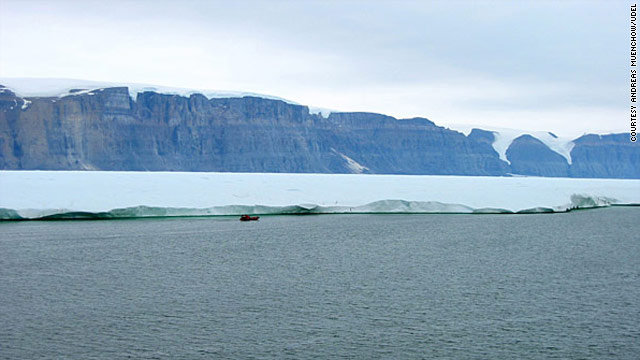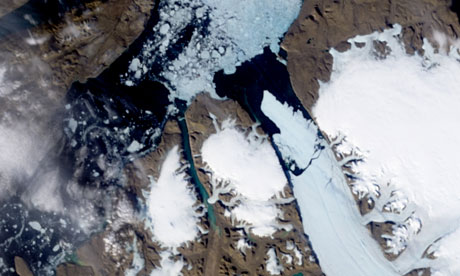The Coming Food Crisis
Global food security is stretched to the breaking point, and Russia's fires and Pakistan's floods are only making a bad situation worse.
BY JOHN D. PODESTA, JAKE CALDWELL | AUGUST 26, 2010

There was already little margin for error in a world where, for the first time in history, 1 billion people are suffering from chronic hunger. But the fragility of world food markets has been underscored by the tragic events of this summer.
The brutal wildfires and crippling drought in Russia are decimating wheat crops and prompting shortsighted export bans. The ongoing floods and widespread crop destruction in Pakistan are creating a massive humanitarian crisis that has left more than 1,600 dead and some 16 million homeless and hungry in a region vital to U.S. national security. These and other climate crises trigger widespread food-price volatility, disproportionately and relentlessly devastating the world's poor.
Less noticed has been the spiking price of wheat -- up 50 percent since early June. The U.N. Food and Agriculture Organization recently cut its 2010 global wheat forecast by 4 percent amid fears of a scramble among national governments to secure supplies. As wheat prices climb, demand for other essential food crops such as rice will increase as part of a knock-on effect on world food markets, driving up costs for consumers. In particular, Egypt and other countries that depend heavily on Russian wheat might see dramatic price increases and unrest in the streets.
Fortunately, there are signs we will likely avoid a repeat of the 2007-2008 food crisis, when prices jumped as much as 100 percent and led to deadly riots in Port-au-Prince and Mogadishu. This year, bumper crops in the United States, alongside replenished wheat stocks globally, may be adequate to offset shortages due to the fires in Russia. But these short-term measures should not lull us into complacency or a false sense of confidence. We still have neither a strategy nor a solution to ending global hunger.
Note;
John D. Podesta is the president and CEO of the Center for American Progress (CAP) and was White House chief of staff under President Bill Clinton. Jake Caldwell is the director of policy for agriculture, trade, and energy at CAP.
In the short term, the United States must implement U.S. President Barack Obama's promise to commit $3.5 billion to food security assistance. Since he made the pledge in 2009, only $812 million has been allocated. Surely the United States can do better, and at a faster pace. Emergency food aid is needed now to prevent famine and needless deaths in Niger, Mali, Chad, Burkina Faso, Mauritania, and northern Nigeria. Congress should increase U.S. contributions to the World Food Program and insist on accountability and reform in the distribution of more than $2 billion in annual U.S. food aid. And the Emergency Food Security Program, which allows greater flexibility in international food assistance by allowing purchases from local producers, cash transfers, and food vouchers, is a step in the right direction and deserves congressional support.
Looking beyond the immediate crisis, the United States and other developed countries must renew long-neglected investments in agriculture assistance across the developing world, targeting small farmers as the fundamental drivers of economic growth. In Africa, for example, agriculture employs more than 60 percent of the labor force and accounts for 25 percent of the continent's economic output. And yet, Africa continues to struggle: Nearly 10 million people in the northern Sahel region are suffering from extreme hunger, and most countries still lack adequate investment in agricultural and road infrastructure to facilitate the development of value-added products and new markets.
While the United States provides more than half of the world's food aid, agriculture assistance today stands at only 3.5 percent of overall U.S. development aid, down from 18 percent in 1979. Not surprisingly, agricultural productivity growth in developing countries is now less than 1 percent annually.
We must also improve how this assistance is targeted. We can reap lasting results by focusing on soil and water conservation and improved crop varieties rather than carbon-intensive fertilizers. Scientific research and appropriate biotechnology can deliver significant crop yield gains and water savings if conducted in a safe and transparent manner. We also must invest in women, who represent up to 80 percent of the food producers in many developing countries, but frequently lack the support and services that will allow them to reinvest hard-earned agricultural gains into health and education for their families.
Internationally, the United States must lead efforts to ensure open and well-regulated agricultural markets. Farm subsidies and tariffs in rich countries must be reduced and commodity markets made more transparent. A recent report from the Organization for Economic Cooperation and Development indicates subsidies for agriculture in the world's richest countries rose to $252.5 billion, or 22 percent of farmers' total receipts in 2009. And impediments to free trade between developing countries must be eliminated.
The Group of Twenty leading developed and developing nations must uphold their pledges of $22 billion to enhance global food security by sending real money out the door. The multilateral Global Agriculture and Food Security Program, a new global partnership funded by commitments from the United States, Canada, South Korea, Spain, and the Bill and Melinda Gates Foundation, is to be commended for issuing $224 million in initial grants to help increase food security and reduce poverty in five developing countries.
But lasting gains in agricultural productivity will require something more -- action to confront climate change. Food shortages resulting from severe crop losses will occur more frequently and take longer to recover from as more people become vulnerable to extreme weather events like the droughts and flooding we see today in Russia and Pakistan. The World Bank predicts that developing countries will require $75 billion to $100 billion a year for the next 40 years to adapt to the effects of climate change on agricultural productivity, infrastructure, and disease.
This year, we may be able to limit the damage to a single supply shock in Russia and Eastern Europe. But even in the best of times, our global food system is stretched to the breaking point by the ever-present challenges of population growth, increased demand from changing diets, higher energy costs, and more extreme weather. Experts at the U.N. Food and Agriculture Organization estimate global agricultural productivity must double by 2050 to keep pace with increased demand. Unless we take immediate action, we are destined to race from food crisis to food crisis for generations to come, with grim consequences for the world's poor and our own national security.
John D. Podesta is the president and CEO of the Center for American Progress (CAP) and was White House chief of staff under President Bill Clinton. Jake Caldwell is the director of policy for agriculture, trade, and energy at CAP.
source;
http://www.foreignpolicy.com/article...ng_food_crisis
*********************************
For More
A Food Program That's Not About Food:
India's starving children don't need more blind handouts. They need real social change.
By Purnima Menon

Last year, the New York Times splashed stark images of child malnutrition in India's hinterland across its front page. More recently, another front-page article in the Times reminded the world that India's hunger problem hasn't gone anywhere and told the story of how various social-safety-net programs have failed to help. As the article explains, India still faces endemic problems with chronic malnutrition and hunger -- rates of child nutrition here compare unfavorably with many countries in sub-Saharan Africa -- that government initiatives have failed to address.
The story of why hunger persists in India is long, sometimes depressing, and full of paradoxes, the central one of course being the fact that the country actually has a booming economy and robust food stocks. But really it's a story of poor planning, social exclusion, gender inequality, and above all, a government that's failing to translate new capital into broad prosperity for its people. Because of this, the various schemes for food distribution debated in the recent Times article, which are part of the conversation as India's long-delayed National Food Security Bill wends its way slowly through the political system, will likely do little to create a long-lasting solution to hunger in India. Any real effort will have to start with the country's social and governance problems, and include nutrition programs that pick their targets better.
India's nutrition programs have failed to provide what the most vulnerable members of its population need -- and the new bill under development isn't likely to do enough to address them either. We've known for a long time that the period beginning before a woman gives birth and ending around the second year of her child's life are the crucial years for addressing nutrition. Miss this window, and the battle is largely lost. India's programs are only now just starting to take this "window of opportunity" paradigm into account. But to actually translate a policy into action, reaching all children under 2 with everything that they need (breast-feeding, high-quality foods, immunizations and preventive health care, hygiene and sanitation, and above all, mothers who are healthy themselves), an approach is required that goes far beyond food distribution.
Taking social exclusion, the evidence has consistently shown that marginalized social groups -- particularly lower castes, certain tribes, and some religious minorities -- have poorer access to social-safety-net services and are also more likely to be excluded from India's rapid economic growth. The stories from Madhya Pradesh portrayed in the Times this year and last year exemplify this social exclusion (as does Foreign Policy's recent story on the resource wars in the nearby provinces of Chhattisgarh and Jharkhand), as they describe the precarious conditions that exist for India's tribal populations, migrant laborers, and extreme poor.
In 2006, the Supreme Court of India asked the government to universalize projects such as the Integrated Child Development Services, the world's largest health, immunization, and nutrition program for young children. This has certainly helped expand services to excluded geographic areas and groups, but ensuring quality of service and reaching the more vulnerable children is still a challenge.
Gender is a problem as well. Research has shown that empowering women is one of the most effective ways to improve nutrition, especially for children. Studies by the International Food Policy Research Institute (IFPRI), where I work, have demonstrated that the low status of women contributes to hunger and malnutrition -- not just among the women themselves, but among their children too.
It's easy to see this process at work in India. South Asia, including India, is one of the worst places in the world to be a woman, especially a poor woman. Sex-selective abortion, female infanticide, low rates of female education, early marriage, domestic violence, and social exclusion of widows create misery across the life cycle. These gender imbalances lead directly to poor nutrition among women, as well as compromising their children's nutrition. Our research in Bangladesh, for example, shows that women who condone domestic violence have children who are more undernourished than those who do not condone violence.
When it comes to children, malnourished women are much more likely to give birth to a low-weight baby -- birth weight being an important predictor of child survival. Not surprisingly, one-third of babies born in India are born with low birth weight, compared with one-sixth in sub-Saharan Africa.
The extent to which women are allowed to control household spending also affects childhood nutrition. Numerous studies, including those by IFPRI, have shown that income or assets controlled by women are more likely to be spent on items that benefit children and themselves, such as food, clothing, and health care, than assets controlled by men.
As with social exclusion, gender inequality has been the target of a number of government and civil society programs. Sex-selective abortion, female infanticide, early marriage, and domestic violence are illegal -- though they still persist. Some states, including Madhya Pradesh, have conditional cash transfer programs aimed at families with girl children. These programs provide financial incentives to families to keep girls in school and delay marriage. Unfortunately, though, little is known about their impact. This is another problem: Well-intentioned investments are made, but without research into outcomes, little is known about how well they work and how they can be made to work better.
Under the best of circumstances, though, reshaping social norms around gender and class could take a long time. Part of the impetus must come from the Indian media, which to their credit have taken an interest in pushing Indians to question the basic assumptions they grew up with. A long-running TV serial, Balika Vadhu (Child Bride), tackles issues of child marriage and ostracism of widows by showing the daily struggles and stories of a girl married as a child and another married early and widowed at age 16. The show is among the top 10 most-watched soap operas in India. In October 2009, Life Gulmohar Style, a 156-episode radio drama by the BBC World Service Trust aired on FM channels of All India Radio and Dhamaal Radio and took on issues of women's rights, including the question of dowry, in the modern world by portraying the lives of five young people, men and women; the BBC World Service Trust will conduct research on the social impact of the show later this year.
Finally, there's the role of good governance in addressing the crisis. As the recent Times story pointed out, vast resources are being lost to bad planning and corruption. The proposed National Food Security Bill aims to guarantee food security for all people in India, using means such as provision of subsidized food grains. However, it is currently caught up in acrimonious back-and-forth between the group of ministers who drafted its early version and critics who would like to see a more encompassing bill. In either case, it doesn't address any of the broader social problems that are really at the heart of the hunger problem in India.
That's a huge niche for government to fill, as a major report last year from the Institute of Development Studies pointed out, suggesting solutions to governance problems such as poor local-area service delivery, poor outreach to excluded groups, and the overall political economy of nutrition in India. There are ongoing experiments with some approaches to increase transparency and accountability: for example, leaning on local-level government or civil society groups to audit programs. Programs like the National Rural Employment Guarantee Scheme, which guarantees 100 days of hard-labor employment to poor rural families and sets a minimum wage rate for such labor, has offered ways to inform communities about their rights and address grievances. Such mechanisms should be tried out in nutrition programs as well.
All these efforts notwithstanding, government has a ways to go, both on the national and local levels -- and outside pressure can help. India's media has been, again, a key player in the fight. The Tracking Hunger campaign by the Hindustan Times has continued to portray different dimensions of the hunger and nutrition problem in India, while other papers have covered discussions surrounding the National Food Security Bill as it continues to be developed. But NGOs and research organizations need to continue to offer material to the media and civil society that puts pressure on Indian policymakers (such as IFPRI's India State Hunger Index), while also asking tough questions about how the current programs are functioning.
International donors and NGOs must work on investing in programs and research with a positive effect on women and marginalized classes and minorities. Nutrition, health, and anti-poverty programs must be designed so that they help women control family resources. Leaders at the G-8 and G-20 must force India to confront the role of social exclusion, gender inequality, and poor governance in malnutrition. Research institutions must make the effort to document the effectiveness and impact of ongoing efforts to address food security and nutrition, to report on people who are left out of such programs, and to tell the positive stories of those who implement successful programs in the face of these hurdles.
India's hunger problem is not necessarily fatal. If the country can take some decisive action, reaching out to women and the poor and excluded and scaling up the social safety net in effective ways, it could make radical changes in a comparatively short time. Countries such Brazil, China, and Thailand have made huge leaps in nutrition in their countries, all in a short period of time. India can hardly afford to be left behind.
source:
http://www.foreignpolicy.com/article...not_about_food








 Reply With Quote
Reply With Quote































Bookmarks